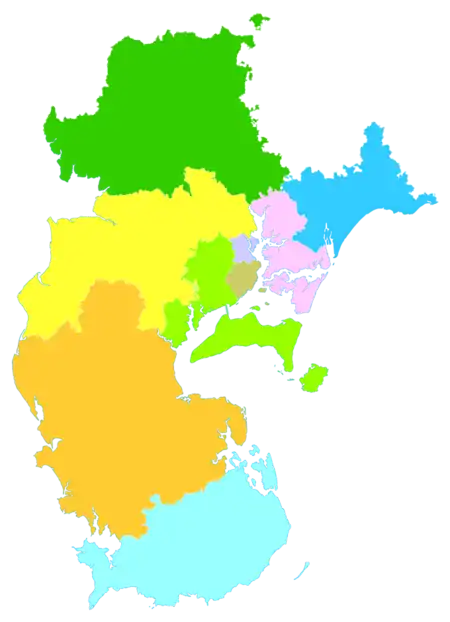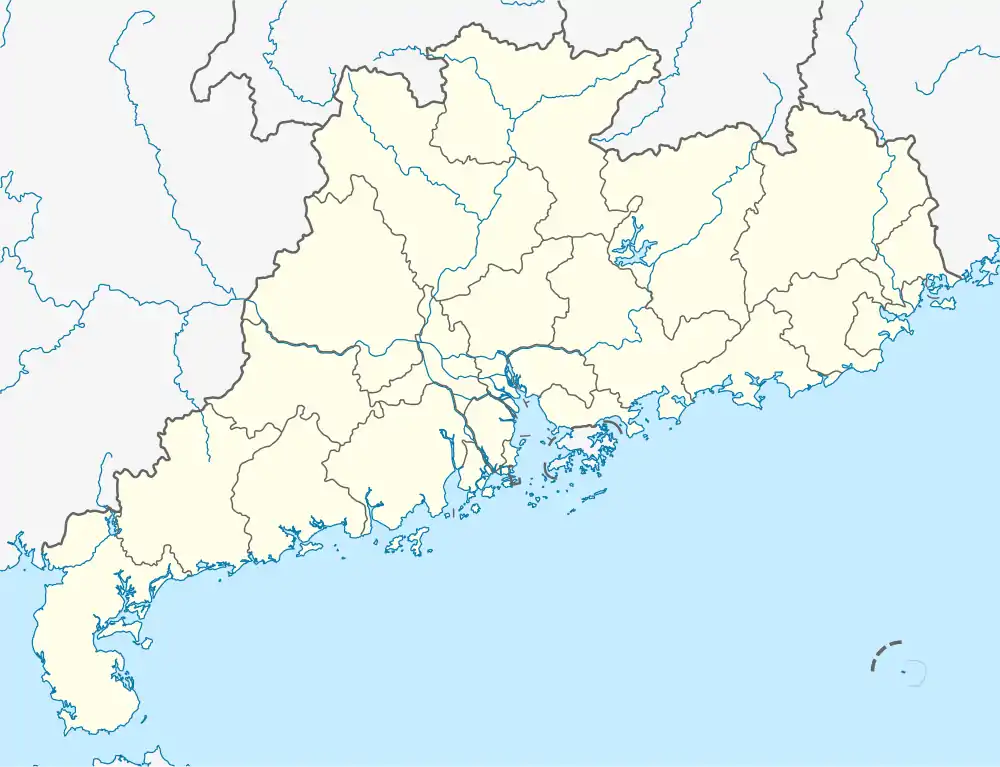Wuchuan
吴川市 Wuchwan | |
|---|---|
 | |
 Wuchuan is the easternmost division of this map of Zhanjiang | |
 Wuchuan Location in Guangdong | |
| Coordinates: 21°26′28″N 110°46′44″E / 21.441°N 110.779°E | |
| Country | People's Republic of China |
| Province | Guangdong |
| Prefecture-level city | Zhanjiang |
| Area | |
| • Total | 848 km2 (327 sq mi) |
| Population (2010 census) | |
| • Total | 927,275 |
| • Density | 1,100/km2 (2,800/sq mi) |
| Time zone | UTC+8 (China Standard) |
| Website | Official website |
| Wuchuan, Guangdong | |||||||||
|---|---|---|---|---|---|---|---|---|---|
| Traditional Chinese | 吳川 | ||||||||
| Simplified Chinese | 吴川 | ||||||||
| Literal meaning | Wu River(s) | ||||||||
| |||||||||
Wuchuan[lower-alpha 1] is a county-level city in the southwest of Guangdong province, China. It is the easternmost county-level division of the prefecture-level city of Zhanjiang. The total area of Wuchuan is 848 square kilometers (327 sq mi), with an estimated population of 1,111,394 in 2013.
History
Under the Sui, Wuchuan was a small county called Wujiang on the nearby Jian River. Under the Qing, Wuchuan was administered from Gaozhou Commandery[1] (now a county-level city within neighboring Maoming Prefecture). On May 26, 1994, the Ministry of Civil Affairs of the People's Republic of China agreed to Wuchuan County's elevation to county-level city status and placed it under the administration of Zhanjiang.
Geography
Wuchuan sits on the Jian River where it empties into the South China Sea, at the eastern coast of the Leizhou Peninsula. It borders Zhanjiang's Potou District to the west, Lianjiang to the west, Huazhou to the north, and the Maoming districts of Maonan and Dianbai to the east and northeast. The time zone for Zhanjiang, as with all locations in the People's Republic of China, is Beijing time (GMT +8).
Climate
| Climate data for Wuchuan (2011–2020 normals, extremes 1981–2010) | |||||||||||||
|---|---|---|---|---|---|---|---|---|---|---|---|---|---|
| Month | Jan | Feb | Mar | Apr | May | Jun | Jul | Aug | Sep | Oct | Nov | Dec | Year |
| Record high °C (°F) | 27.4 (81.3) |
30.7 (87.3) |
30.6 (87.1) |
33.6 (92.5) |
36.0 (96.8) |
37.7 (99.9) |
38.5 (101.3) |
38.5 (101.3) |
37.0 (98.6) |
34.7 (94.5) |
33.0 (91.4) |
28.8 (83.8) |
38.5 (101.3) |
| Mean daily maximum °C (°F) | 20.0 (68.0) |
20.7 (69.3) |
23.5 (74.3) |
26.3 (79.3) |
29.7 (85.5) |
31.3 (88.3) |
31.4 (88.5) |
31.6 (88.9) |
31.3 (88.3) |
29.2 (84.6) |
26.2 (79.2) |
21.4 (70.5) |
26.9 (80.4) |
| Daily mean °C (°F) | 16.1 (61.0) |
17.1 (62.8) |
20.3 (68.5) |
23.4 (74.1) |
27.1 (80.8) |
28.7 (83.7) |
28.7 (83.7) |
28.4 (83.1) |
27.7 (81.9) |
25.2 (77.4) |
22.3 (72.1) |
17.3 (63.1) |
23.5 (74.4) |
| Mean daily minimum °C (°F) | 13.7 (56.7) |
14.9 (58.8) |
18.2 (64.8) |
21.5 (70.7) |
25.1 (77.2) |
26.5 (79.7) |
26.6 (79.9) |
26.0 (78.8) |
25.1 (77.2) |
22.3 (72.1) |
19.6 (67.3) |
14.5 (58.1) |
21.2 (70.1) |
| Record low °C (°F) | 5.3 (41.5) |
4.3 (39.7) |
5.1 (41.2) |
11.4 (52.5) |
16.8 (62.2) |
19.2 (66.6) |
22.6 (72.7) |
22.4 (72.3) |
17.3 (63.1) |
13.6 (56.5) |
6.7 (44.1) |
4.0 (39.2) |
4.0 (39.2) |
| Average precipitation mm (inches) | 35.2 (1.39) |
32.2 (1.27) |
49.3 (1.94) |
129.0 (5.08) |
181.1 (7.13) |
249.5 (9.82) |
236.7 (9.32) |
280.2 (11.03) |
201.2 (7.92) |
90.8 (3.57) |
32.5 (1.28) |
37.1 (1.46) |
1,554.8 (61.21) |
| Average precipitation days (≥ 0.1 mm) | 6.0 | 8.4 | 9.4 | 11.0 | 14.0 | 15.4 | 14.2 | 16.8 | 14.0 | 6.7 | 5.1 | 5.2 | 126.2 |
| Average relative humidity (%) | 78 | 84 | 86 | 87 | 86 | 85 | 84 | 84 | 81 | 75 | 74 | 73 | 81 |
| Mean monthly sunshine hours | 128.3 | 98.8 | 92.0 | 122.9 | 180.4 | 197.6 | 232.9 | 212.7 | 201.3 | 216.0 | 183.6 | 153.8 | 2,020.3 |
| Percent possible sunshine | 38 | 31 | 25 | 32 | 44 | 49 | 57 | 54 | 55 | 60 | 55 | 46 | 46 |
| Source: China Meteorological Administration[3][4] | |||||||||||||
Culture
Language
Three main language varieties are spoken in Wuchuan.[5]
- Baihua 白话: a Yue Chinese dialect
- Donghua 东话 (Leihua 雷话): a Southern Min Chinese dialect spoken in Lanshi 兰石, Tanba 覃巴, Wangcungang 王村港
- Haihua 海话 (Jizhao 吉兆话): spoken on the coast
The spoken language in Zhanjiang's northern downtown districts is largely Cantonese while Leizhou Min is the prestige language in Mazhang District, Leizhou City and other nearby counties. The dialect in Lianjiang County is Hakka.
The Jianjiang drainage basin is a region where people of Han nationality and the other Baiyue ethnic groups had lived together throughout history. Local authorities subordinated to a central government of Han nationality have existed since the Northern and Southern Dynasties. The establishment of the local government of Luozhou and Gaozhou and their close relationships with Guangzhou have promoted the Hanization of the local Baiyue ethnic groups, which in turn has led to the formation of Wuchuan-Huazhou Cantonese, a dialect of Chinese.[6]
Folk Custom
- Piaose
Piaose was a kind of important folk art in Guangdong province. As time went by, it has disappeared in many places. But in Wuchuan, it still connect with local persons' life and local culture. Wuchuan Piaose has great aesthetic value, artistic value and humanistic value. It integrates idiographic pictures basing on its source and constitution. At the same time, Wuchan Piaose is also facing the attack of foreign culture, inderitente, funding, publicity and artistic innovation. In 2009 July, Wuchuan Piaose team was invited to take part in the "Chengdu International Intangible Cultural Heritage festival".
- Clay Sculpture
Clay sculpture is an "Original Art", and its original characteristic determines that it is one of the most ancient human arts. Clay sculpture not only records folk life, but also creates the colourful art space. The regionality and stability of clay Sculpture art represent the people's value orientation and aesthetic experience. Protecting its "cultural difference" and aesthetic multiformity becomes an important strategy for the survival of China's contemporary clay sculpture art.[7]
- Years-cases
Years-cases are activities of local characteristics in the western Guangdong. This festival based on local god. Years-cases fill with many kinds of fastidious complex sacrifice ceremony. And all rituals are conducted as one. Years-cases are composed of four sections such as the gods of years-cases, rituals of years-cases, opera of years-cases and feast of years-cases. The gods of years-cases is the core of years-cases. The chapter mainly focuses on the changes of years-cases gods' image. The images tend to complicate things. There are two major patterns to the changes of gods' images. For example, it is a combination of multiple gods' images. Moreover, there are several different gods in the same ritual of years-cases. The changes of gods show people's ideas and concepts. God's parade is the most important part of the years-cases' ritual. It reflects people's culture or faith. We will use the field survey of Beiyue village's ritual as an example. And then we focus on the patterns of years-cases' ritual in the changes. It is planning to go in for further studies in secularization and commercialization of years-cases. Opera of years-cases means mainly opera performance in the night The ritual and opera must fit together and complement each other. Opera is one of the ceremonies. At the same time actor is a priest. It focuses on years-cases' allegorizations. Feast of years-cases also is a ritual. Symbolically food is consumed by people. It is a ritual process. Local eating habits defend the eating culture. Needs of symbolically food is to develop the pig industry and poultry industry in Wuchuan.[8]
Historic locations
- Maoshan Ancient Academy
A library built 1700 years ago by Wang Jun. It is located in the Wuchuan Bo Pu Zhen.
- Xiangshan Ancient Temple
Built in 283, the Xiangshan Temple has been rebuilt several times. Today it lies on Wuchuan Popu.
Famous Persons
- Lin Shaotang (1786~1872), an ethnic Putianese Min person from Wu Yang Zhen, one of the champions of Imperial Examination. He was one of the few overseas ethnic Putian Min champions.
- Chen Lanbin (1816~1895) A minister and scholar in the late Qing Dynasty, born in Huang Po Zhen. He was the first Chinese ambassador to the United States.
- Li Hanhun (1894-1987) graduated from Baoding army officer school in 1919. In 1926 he participated in the northern expedition. During the Second Sino-Japanese War, he was an army colonel who served as commander of Army Group Commander, and as chairman of the Guangdong provincial government.
- Liu Huaqiu (1939- ) deputy director of the Center for International Economic Exchanges.
- Yu Yilong (1965- ) the famous Chinese hard pen calligrapher.
Education
Up to 2013, there are 468 schools on all levels in Wuchuan, including 1 teacher training school, 11 middle schools and 296 primary schools. There are 206,202 students studying at schools, including 97,778 high schools students, 77,179 primary school students and many nursery school students.
- Wuchuan NO.1 Middle School
It was founded in 1927, November 11 and it was the most famous school in Wuchuan. Each year, about 3,000 students graduated from this middle school and most of them can enter in good universities.
- Wuchuan NO.3 Middle School
It was founded in 1964 and it developed really fast. It is one of the best middle school in Wuchuan.
Notes
References
- 1 2 Gützlaff, Charles (1838), China Opened, p. 527.
- ↑ Chisholm, Hugh, ed. (1911). . Encyclopædia Britannica. Vol. XV (11th ed.). Cambridge University Press.
- ↑ 中国气象数据网 – WeatherBk Data (in Simplified Chinese). China Meteorological Administration. Retrieved 28 May 2023.
- ↑ 中国气象数据网 (in Simplified Chinese). China Meteorological Administration. Retrieved 28 May 2023.
- ↑ Shao Lanzhu [邵兰珠]. 2016. Guangdong Jizhaohua yanjiu [广东吉兆话研究]. M.A. dissertation: Guangxi University for Nationalities [广西民族大学].
- ↑ Li, Jian. "history of forming of Wuchuan-Huazhou Cantonese". Zhanjiang Teachers' College Journal. 35 (1006-4702(2014)04-0107-04). Retrieved. 2014-12-25.
- ↑ Lin, Jifu. from clay to art. journal of yangtze university. p. 22. Retrieved. 2014-12-25.
- ↑ Chen, Hanwei. the transition of Zhanjiang's Years-cases. Guangxi Normal university. p. 5. Retrieved. 2015-01-13.